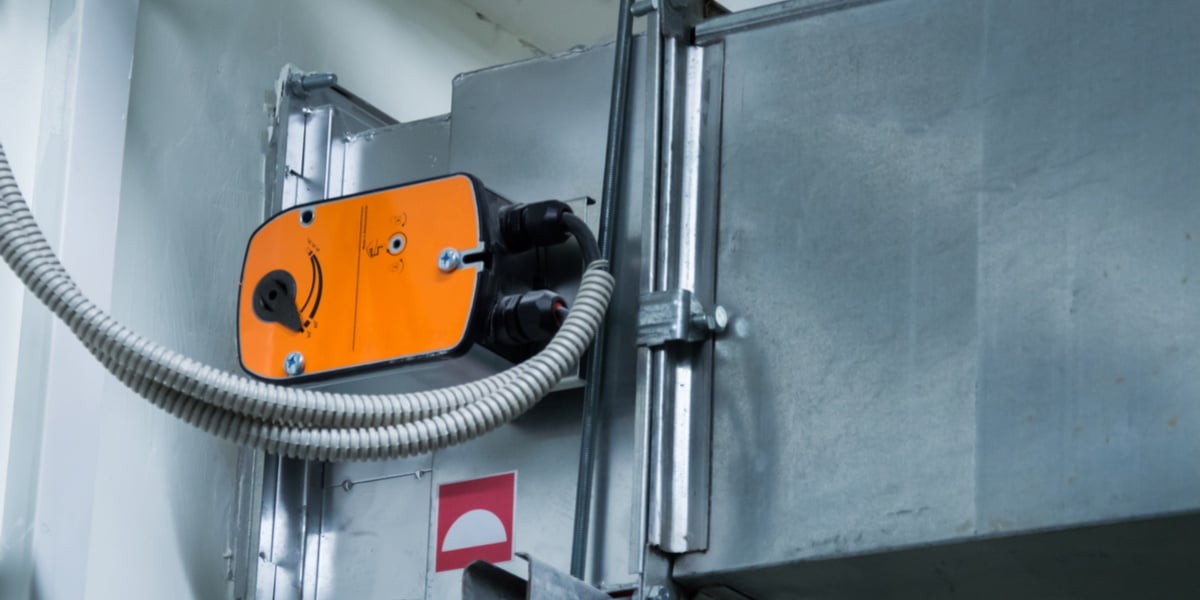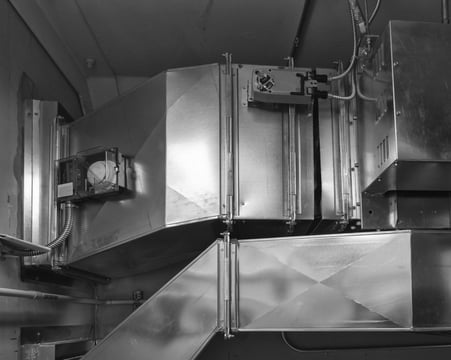Air Dampers: A Detailed Guide

An air damper is a device that uses valves or plates to stop or regulate the flow of air within a duct, chimney, variable-air-volume (VAV) box, air-handling unit or other similar pieces of equipment. Dampers are also used to stop airflow into unoccupied or unused rooms where air conditioning is not required. In addition, dampers can also be used as protection measures against smoke or fire.
An air damper is a complex mechanism with many moving elements. Their main components are the blades, which adjust their position to control airflow. In addition, dampers include frames, linkages, axles, bearings, seals, blade pins, actuating motors, flanging, jackshafts, and sleeves, among other components.
Types of Air Dampers
Based on their construction, air dampers can be classified into parallel blade and opposed blade dampers. Each configuration has unique performance features and is intended for different applications.
1) Parallel Blade Dampers
In this type of air damper, blades rotate in the same direction, parallel to one another. The parallel blade configuration is typically used when the damper operates in two positions: open or closed.
These dampers redirect air flow along their first few degrees of rotation, as they move from fully open to closed, and therefore control is achieved along the first 20-30% of movement. Rather than modulating air streams, these dampers change their direction, and that is the main reason why they are preferred for open-close operation or fixed flow control.
Parallel blade dampers are typically used in applications where the damper represents a major portion of the overall system pressure loss. They should not be used upstream of critical components due to their uneven airflow.
2) Opposed Blade Dampers
In this type of air damper, blades rotate in opposite directions to one another, modulating airflow. These air dampers are mostly used when the system requires airflow control rather than open-close operation, but they can also be used for on-off service.
Opposed blade dampers are typically used in the following applications:
- When the damper doesn’t represent a major portion of the overall system pressure loss.
- Systems that are required to maintain an even airflow downstream from the damper.
- Ducted terminals.
Improve Your HVAC Performance – Talk to Our MEP Design Specialists!
Classification of Dampers by Control Method and Application
Air dampers can also be classified based on the control method they deploy and their intended application. Based on their control method, dampers can be either automatic or manual:
- Automatic dampers are similar to automatic control valves in terms of functioning.
- Manual dampers are adjusted manually depending on the required airflow, as implied by their name.
Dampers can also be classified based on their application, and the following are some of the main types:
- Balancing dampers (volume dampers)
- Face and bypass dampers
- Fire dampers
- Smoke dampers
- Combined fire and smoke dampers
- Gravity dampers (backdraft or barometric)
- Mixing dampers
- Multi-zone dampers
- Round dampers
- VAV boxes (variable-air-volume)
Note how dampers are not only used for air balancing in ventilation systems, but also for safety in fire protection applications.
Why Are We Concerned About Dampers?

Air dampers are an important element of MEP engineering design, since their use is subject to code requirements. They should also be designed to minimize energy losses, through the prevention of heat exchange across them when in the closed position, all while maintaining the required pressure conditions in different spaces.
In NYC, air dampers are subject to the following codes and standards:
- National Fire Protection Association (NFPA) standards:
- NFPA 90A Standard for the Installation of Air-Conditioning and Ventilating Systems
- NFPA 92A Standard for Smoke-Control Systems Utilizing Barriers and Pressure Differences
- NFPA 101 Life Safety Code
- Underwriters Laboratories (UL) standards:
- UL 555 Standard for Fire Dampers
- UL 555S Standard for Smoke Dampers
- UL 555C Standard for Ceiling Dampers
- NYC Building Code
- NYC Mechanical Code
The main locations where air dampers are required to meet code are the following: stair enclosures, elevator shafts, common corridors, mechanical rooms, fire-rated walls, exterior building walls, shaft enclosures, horizontal assemblies, and duct and transfer openings.
Air Dampers in Fire Protection Applications
The three main types of dampers used in fire protection applications are fire dampers, smoker dampers and combined fire/smoke dampers. This section provides an overview of each type and its applications.
Fire Dampers
Fire dampers interrupt airflow through the duct automatically, restricting the passage of flames. To accomplish their function, these dampers are installed in ducts that cross fire-rated assemblies or fire-rated walls. They can be installed in both horizontal and vertical ductwork, and can be of both curtain type and multi-blade type.
A fire damper has the following components:
- Sleeve
- Curtain blade
- Break-away joints
- Fusible link
- Access door to inspect the fire damper
All fire dampers are installed in the open position, with a fusible link. When the temperature in the ductwork exceeds a specified value, the fusible link melts and the damper gets shut off, either by gravity or by a spring. To guarantee they accomplish their function, fire dampers need to pass various tests.
Fire damper selection is based on three main factors: fire resistance rating, temperature and operation range. Fire rating depends on the time span for which a damper will withstand the heat associated with a fire. For walls, partitions and barriers with fire resistance rating of less than 3 hours, 1.5-hour fire dampers are used. For fire barriers rated for 3 hours or more, 3-hour fire dampers are used. This procedure ensures building code compliance, which require that the fire resistance rating be maintained across the full area of walls, partitions and floors.
The exceptions for the use of fire dampers are parking garages, kitchen exhaust ductwork, and dryer exhaust ductwork.
Smoke Dampers
Smoke dampers prevent smoke from spreading in HVAC systems that are designed to shut down automatically in case of fire, and they only have two positions: open and closed. These dampers are installed in a slotted duct section - they are installed whenever a duct penetrates a smoke partition or smoke barrier inside the building. They can be applied in passive smoke control systems, or as part of an engineered smoke control solution.
In passive systems, smoke dampers close and prevent the circulation of air and smoke through ducts or ventilation openings that cross a smoke barrier. On the other hand, in engineered smoke control systems, the spread of smoke is controlled by the building HVAC system or by dedicated fans that create pressure differences. Smoke dampers may be controlled by heat sensors, smoke sensors, fire alarms, or any other method that meets the design intent.
A smoke damper has the following components:
- Sleeve
- Smoke blades (parallel)
- Break-away joints
- Duct-mounted smoke detector
- Damper actuator
- Access door
It is important to decide which ratings are required for UL Listed fire dampers. They are summarized in the following table:
|
SMOKE DAMPER RATING |
DESCRIPTION |
|
1) Leakage |
Class I (lowest) or Class II (highest). The International Building Code requires a minimum of leakage class II, but leakage class I is recommended to provide the highest protection level. |
|
2) Elevated temperature |
250 or 350°F (121 or 177°C). 350°F (177°C) is most often selected for the highest level of safety. |
|
3) Velocity and pressure |
UL555S requires each smoke damper, with its installed actuator, to be rated for opening against a specific pressure differential (inch wg) and to close against a specific velocity or airflow (fpm). Dampers should be selected to operate at the pressures and velocities they will encounter in their application, with a minimum of 4 inch wg (1 kPa) and 2000 fpm (10.2 m/s) |
|
4) Electric and pneumatic actuators |
Electric and pneumatic actuators that have been UL tested and approved with the damper as a matched set are factory-assembled. |
- The SD-1320 and SD-1330 smoke dampers are UL/cUL leakage rated dampers, listed under the latest UL 555S standard.
- SD-1620 smoke dampers meet UL Class II. Leakage is less than 20 cfm per square foot at 4 inch w.g. and at 350°F (177°C).
- SD-1630 smoke dampers meet UL Class I. Leakage is less than 8 cfm per square foot at 4 inch w.g. and at 350°F (177°C).
Fire and Smoke Damper (Combined)
As implied by its name, this type of damper is a combination of a fire damper and a smoke damper, and it is installed in ducts that cross partitions rated as both fire and smoke barriers. This type of damper must be qualified under both UL555 and UL555S.
Selection of a combined fire and smoke damper depends upon 4 factors: fire resistance rating, leakage rating, temperature and operational ratings.
Combined fire and smoke damper applications include walls, floors, partitions required by the local building code. For walls, partitions and barriers with fire resistance rating of less than 3 hours, 1.5-hour fire/smoke dampers are used. For fire barriers rated for 3 hours or more, 3-hour fire/smoke dampers are used.
UL Standard 555S identifies the three leakage classes given in the following table. It provides leakage in cfm per square foot for each class and for various static pressure values:
|
Class |
Static Pressure (inch w.g.) |
|||
|
1 |
4 |
8 |
12 |
|
|
I |
4 |
8 |
11 |
14 |
|
II |
10 |
20 |
28 |
35 |
|
III |
40 |
80 |
112 |
140 |
Designers are usually suggested to pick a very low leakage category.
Conclusion
Air dampers have a wide range of applications, ranging from airflow modulation in normal operating conditions, to providing a reliable barrier against smoke or fire during emergencies. However, code compliance is an important aspect to consider regardless of the application, so working with qualified HVAC professionals is highly recommended.
Make sure your mechanical installations are code compliant and energy efficient, while getting a 50% faster turnaround. You can contact Nearby EngineersNew York Engineers by email (info@ny-engineers.com) or phone (786) 788-0295212-575-5300.

Sanket Abhang
Sanket Abhang is a Plumbing and Fire Protection Design Engineer who holds a Mechanical Engineering Degree from the University of Mumbai, India. Recent projects include Community Access, Jackson Avenue, 330 Grand Street and many private residences & commercial kitchens.
Related Posts
Join 15,000+ Fellow Architects and Contractors
Get expert engineering tips straight to your inbox. Subscribe to the NY Engineers Blog below.



